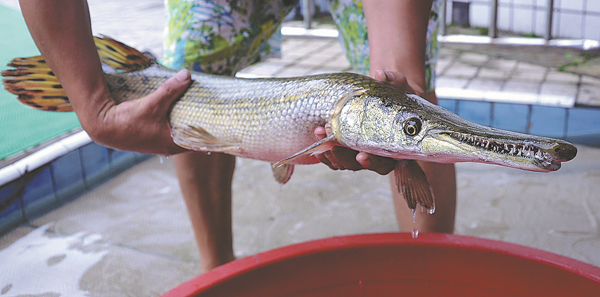Razor-toothed fish species invading parts of country

The alligator gar was a mystery to most people in China last month, but now it has become widely known as a smart, alien invasive fish species.
The ray-finned euryhaline fish, which is also known for its ravenous appetite, hit the headlines following the capture of two in a park in Ruzhou in Henan province. The capture, which was livestreamed on Aug 23, attracted about 37 million viewers at its peak.
The razor-toothed fish were captured late on Friday. But they didn't go easily.
It took firefighters and civilian water rescue teams almost two days, even after the park's management authority spent almost a month draining most of water from the lake where they were hiding. The diverted water was enough to fill 34 Olympic swimming pools.
When park management was first approached by a resident with a video of a "monster" fish about 80 centimeters in length, they didn't pay it much attention.
"At the beginning, we thought it was just a large common fish," said Qi Li, head of maintenance at the park, adding that they believed the fish could be caught in a net.
They never expected the video would go viral or that the fish would be identified by netizens as an alligator gar, a fish originally from North America, a view endorsed by water resource experts after the local agriculture authorities turned to them for help.
"They presented the fish as an invasive species capable of inflicting great damage on the local ecosystem… and as a threat to safety once they reach adulthood," Qi said, adding that the park authority quickly launched a capture operation, but was unable to succeed for over two weeks.
Using a sonar device, two members of a civilian water rescue team scanned the 6.7-hectare lake with an average depth of 1.3 meters, inch by inch. However, after six hours, they'd found nothing but the aquatic plants that cover half of the lake bed.
The "monster" never showed up.
"It is very crafty," Qi said.
Additional equipment was brought in but the park authority's efforts to divide the lake into four segments to catch the fish also ended in failure. They had failed to even sight it as of July 26-about 10 days since the hunt began-apart from finding out that some of the equipment broke.
Following consultation with multiple local government bodies, a new plan was hammered out to dry up the lake, which was only half full due to the ongoing drought affecting large swathes of the country. The team combed through the remaining water on Tuesday after the pump was no longer able to drain any more water. The fish, however, was still nowhere to be seen.
With support from the local departments of agriculture and urban-rural development, an even larger team of 50, including firefighters and members of civilian rescue teams, was mobilized to search for the fish in its last possible shelter, a 180-meter-long culvert with a depth of up to 20 meters.
On Thursday morning, three divers from the Fengmaqi civilian rescue team were forced to turn back after only 50 meters because of a lack of oxygen, according to the team's head, Cui Shaohui.
Cao Ajie, who is with a local branch of the Blue Sky rescue team headquartered in Beijing, entered the culvert on Thursday afternoon."It is very steep. The mud made it very slippery and dangerous," he said.
The arduous search mission was made even more challenging by rain on Thursday and Friday, which swelled the water in the culvert, leading to the mission's suspension. The pump had to be turned on again before it could continue.
Despite these setbacks, the two alligator gars were captured late on Friday and have been disposed of humanely, but the struggle against invasive species has hardly come to an end.
They were not the first instance of the invasive species being found in China. In one of the latest instances, an alligator gar in a pool in a residential community in Jingjiang in Jiangsu province bit a boy's finger and on Friday, another alligator gar was captured in a pool in a residential community in Kunming, capital of Yunnan province, after it was drained by the community's property management company.